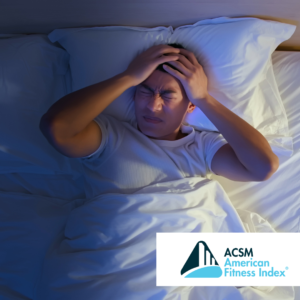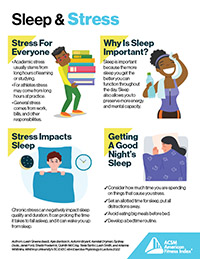
Have you ever gone to sleep at night and woke up the next day feeling groggy and unrested? Or not be able to fall asleep at all due to stress? The need for and benefits of quality sleep cannot be overemphasized, but how can people actually get to a point where they are reaching adequate sleep? What actions can an individual take to ensure a full night’s rest? Research suggests that there are multiple ways to help get a good night’s sleep and reduce stress in doing so (good sleep hygiene). We’ll discuss some stress-related reasons individuals struggle to get adequate sleep, and some research-backed sleep hygiene recommendations to combat those challenges.
Daily stress can have an impact on an individual’s sleep schedule, and persistent stress can contribute to the development of sleep disorders. It is estimated that 10-30% of adults are diagnosed with insomnia, a sleep disorder in which it is difficult for an individual to fall asleep, stay asleep or return to sleep after waking up. Whether short- or long-term, the effects of insomnia include excessive daytime sleepiness, fatigue, irritability and other impairments while awake. Stress-induced sleeping disorders such as insomnia are commonly seen in college students, especially student-athletes who may struggle to balance the various demands on their time and energy. When this stress disrupts sleep, it can have an impact on students’ academic performance, mood and athletic performance. For individuals of all ages, the continuation of interrupted sleep will not only take a toll on the individual and their own body, but those around them will begin to experience the effects as well.
The hypothalamic-pituitary-adrenal (HPA) axis is one of the main neuroendocrine systems active during sleep. Stress-related insomnia activates the HPA. When the HPA is activated as a defensive mechanism to maintain homeostasis, it results in the release of corticotropin-releasing hormone (CRH), adrenocorticotropic hormone (ACTH), cortisol, epinephrine and norepinephrine, which are associated with attention and arousal. Since the hypothalamus plays a key role in sleep regulation, studying it allows researchers to understand the neural mechanisms of sleep disorders, see how each body system is affected, and develop interventions for better sleep.
Some types of stress can develop into mental disorders such as Post-Traumatic Stress Disorder (PTSD) and/or depression. PTSD is a condition caused by severe trauma and can affect people of all age groups. Increased levels of Interleukin-6 (IL-6) and C-reactive protein (CRP) in the body are often a sign of stress. These inflammatory markers have been found to be directly linked to symptoms of depression, especially when sleep quality is poor. Overall, individuals who have been diagnosed with a mental disorder often are characterized by their exhaustion levels and the lack of the ability to get proper sleep.
Awareness of the connection between stress and sleep is the first step in making positive lifestyle changes. Some of the most recommended methods of sleep hygiene are having a consistent pre-sleep routine, a steady bedtime paired with a consistent wake time, developing a bedtime routine such as limiting caffeine intake and screens 90 minutes before bedtime and only using a bed for sleeping. Specific recommendations to reduce stress to assist with better sleep are to participate in regular physical activity (at least 30 minutes per day, 3-5 days per week), using relaxation and deep breathing techniques and participation in other behavioral stress management activities. The goal behind all these methods is to train the brain to associate similar circumstances and times with sleep and in doing so, making it easier to fall asleep. These methods, when combined, can really make a noticeable and positive difference in an individual’s sleep patterns.
Treatment for stress-related sleep disorders for athletes at all levels is similar to treatment for the general population, but the athletes’ sport-specific needs should be kept in mind. Napping is a common sleep disorder intervention, particularly among student-athletes, but the findings are mixed with respect to athletic performance.
Want to learn more about the connection between sleep and athletic performance? Check out this online course: Sleep Tactics for Better Performance.
Authors: Nicole Weiss (lead), River Anderson, Serenity Collier, Vivian Gardner, Reid Moser, Christian Peters, John Hampton Ratcliffe, Paolo Tedesco
Winthrop University, Rock Hill, SC EXSC 484 Exercise Physiology II Lecture, Fall 2022
Instructor: Janet R. Wojcik, Ph.D., FACSM



